




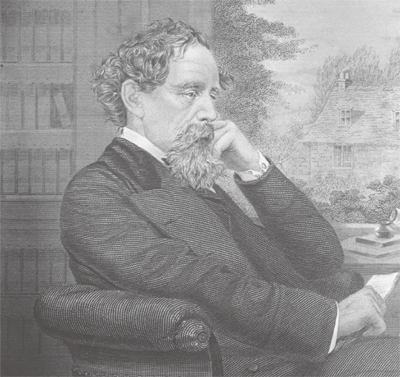

音频
他是怀揣演员梦的少年,因为偶然的杂志委托,踏上文学之路并成为维多利亚时代文学的标志性人物。他是位风格大师,他的作品既有阳春白雪,也有下里巴人,从维多利亚时代至今,经久不衰。他凭借勤奋和天赋塑造一个个经典文学形象,其中许多人物被当作道德的试金石。他用幽默风趣的语言在浪漫与现实中穿梭,为英国乃至世界的批判现实主义文学做出了卓越贡献。他去世时,世人把他当作第一位文学名人哀悼。时至今日他的伟大地位依然无人能撼。他,就是狄更斯。
In 1812, the year Charles Dickens was born, there were 66 novels published in Britain. People had been writing novels for a century, but nobody aspired to do it professionally. Many works of fiction appeared anonymously, with attributions like "By a Lady." The steam-powered printing press was still in its infancy; the literacy rate in England was under 50%. And novels, for the most part, were looked upon as silly, immoral,
toxic
 or just plain bad.
or just plain bad.
In 1870, when Dickens died, the world mourned him as its first literary celebrity: a career writer and publisher, famous and beloved, who had led an explosion in both the publication of novels and their readership and whose characters were held up as moral touchstones. Today Dickens’ greatness is unchallenged. Evicting him from the
pantheon
 of English literature would make about as much sense as the
Louvre
of English literature would make about as much sense as the
Louvre
 selling off the Mona Lisa.
selling off the Mona Lisa.
How did Dickens get to the top? For all the sentiment readers
attach to
 stories, literature is a
numbers game
stories, literature is a
numbers game
 , and the test of time is exceedingly difficult to pass. Some 60,000 novels were published in the
Victorian era
, and the test of time is exceedingly difficult to pass. Some 60,000 novels were published in the
Victorian era
 , from 1837 to 1901; today a casual reader might be able to name a half-dozen of them. It's partly that Dickens was a stylistic genius, whose writing attracted audiences
highbrow
, from 1837 to 1901; today a casual reader might be able to name a half-dozen of them. It's partly that Dickens was a stylistic genius, whose writing attracted audiences
highbrow
 and low. It's partly that his career rode a wave of social, political and scientific progress. But it's also that he rewrote the culture of literature and put himself at the center. No one will ever know what mix of talent, ambition, energy and luck made Dickens such a singular writer. But as his bicentenary arrives, it is possible to understand how he made himself a lasting one.
and low. It's partly that his career rode a wave of social, political and scientific progress. But it's also that he rewrote the culture of literature and put himself at the center. No one will ever know what mix of talent, ambition, energy and luck made Dickens such a singular writer. But as his bicentenary arrives, it is possible to understand how he made himself a lasting one.
Dickens got into novel writing by accident. As a young man, he longed to be an actor and trained to be a reporter. He
dashed off
 fictional stories from time to time. In 1836 he accepted a magazine commission to write a series of
comic sketches
fictional stories from time to time. In 1836 he accepted a magazine commission to write a series of
comic sketches
 , at 14 a month, to accompany a set of illustrations of sporting life. The result, The Posthumous Papers of the Pickwick Club, was a sensation. It established Dickens as a peerless
ventriloquist
, at 14 a month, to accompany a set of illustrations of sporting life. The result, The Posthumous Papers of the Pickwick Club, was a sensation. It established Dickens as a peerless
ventriloquist
 , able to channel the voices of both
swells
, able to channel the voices of both
swells
 and servants, and as a gifted writer of serials, which became the standard method of publication in an era when books were expensive but cheap periodicals thrived. Most important in terms of his legacy, The Pickwick Papers established him as a financially viable artist,
bestriding
and servants, and as a gifted writer of serials, which became the standard method of publication in an era when books were expensive but cheap periodicals thrived. Most important in terms of his legacy, The Pickwick Papers established him as a financially viable artist,
bestriding
 the gap between creativity and commerce. From Pickwick to his deathbed, he wrote for an audience, and he wrote for money—two forces that before his time had had little to do with art.
the gap between creativity and commerce. From Pickwick to his deathbed, he wrote for an audience, and he wrote for money—two forces that before his time had had little to do with art.
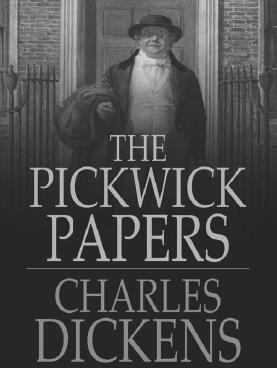
《匹克威克外传》英文版封面
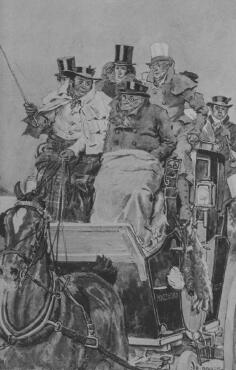
《匹克威克外传》英文版中的插图
Dickens’ commitment to his audience also struck a contradictory balance: he cultivated a mass readership by creating a sense of personal intimacy. Readers felt he was speaking directly to them, and often he did. He channeled his
thespian
 ambitions into live dramatic readings; his
bloodcurdling
ambitions into live dramatic readings; his
bloodcurdling
 performance of the brutal killing of Nancy in Oliver Twist caused fainting
spells
performance of the brutal killing of Nancy in Oliver Twist caused fainting
spells
 among audience members. "He invented that form of publicity," says Nicholas Dames, a Victorian scholar and chair of the English department at Columbia University. "He invented merchandising. All those things that we associate with publishing culture—he was essentially the first." And Dickens knew it. He called himself the Inimitable, a nickname that stuck.
among audience members. "He invented that form of publicity," says Nicholas Dames, a Victorian scholar and chair of the English department at Columbia University. "He invented merchandising. All those things that we associate with publishing culture—he was essentially the first." And Dickens knew it. He called himself the Inimitable, a nickname that stuck.
As his audience grew, Dickens took great care to keep his populist touch. Midway through the writing and publication of David Copperfeld, he received a letter from an acquaintance objecting to a minor character, Miss Mowcher, who is implicated in a scheme involving the seduction of David's childhood friend Little Em’ly. Like the letter writer, Miss Mowcher happened to be a dwarf. Dickens responded that all his characters were composites and he hadn't meant to suggest that
deformity
 of size might signify deformity of soul. But when Miss Mowcher reappears in the novel, he
backpedals
of size might signify deformity of soul. But when Miss Mowcher reappears in the novel, he
backpedals
 and clears her of any wrongdoing. It's an awkward, implausible scene, but Dickens cared more about
appeasing
and clears her of any wrongdoing. It's an awkward, implausible scene, but Dickens cared more about
appeasing
 his wounded reader. He felt responsible to her, and to all his readers, and they adored him in return.
his wounded reader. He felt responsible to her, and to all his readers, and they adored him in return.
As immediate as the response was to his work, Dickens knew that his writing was only as powerful as his ability to control it. Authors possessed limited copyright protection in England at the time his career began and virtually none abroad. American magazines pirated his work outright. Dickens fought successfully for stronger terms of copyright in England and for international agreements to prevent unauthorized translations and theft. He even advocated for an authors’ union. As the editor of two weeklies, he was cultivating new talent and he wanted writers to profit from their work, during and after their lifetime.
He also began to think posthumously in his fiction. His early novels were rooted in problems specific to his time: the
Poor Law
 of 1834 (Oliver Twist), the abusive schools in Yorkshire (Nicholas Nickleby). As he matured, his criticism became more
oblique
of 1834 (Oliver Twist), the abusive schools in Yorkshire (Nicholas Nickleby). As he matured, his criticism became more
oblique
 . He invented grand,
allegorical
. He invented grand,
allegorical
 evils: the
Circumlocution Office
evils: the
Circumlocution Office
 in Little Dorrit, the parasitic court case of
Jarndyce & Jarndyce
in Little Dorrit, the parasitic court case of
Jarndyce & Jarndyce
 in Bleak House—giant grinders of corruption and inefficiency that
mangled
in Bleak House—giant grinders of corruption and inefficiency that
mangled
 all who entered them. When people read Oliver Twist, they knew whom to blame and what to fix. With Dickens’ later novels, says Dames, "You can't identify who the bad guy is anymore. Everything seems so systemic."
all who entered them. When people read Oliver Twist, they knew whom to blame and what to fix. With Dickens’ later novels, says Dames, "You can't identify who the bad guy is anymore. Everything seems so systemic."
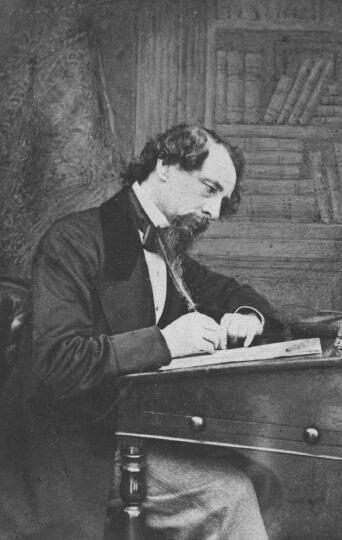
狄更斯在写作
Critics found these novels dreary and
diffuse
 .
Henry James
.
Henry James
 , reviewing Our Mutual Friend for the Nation in 1865, wrote, "For the last 10 years it has seemed to us that Mr. Dickens has been unmistakably forcing himself. Bleak House was forced; Little Dorrit was labored; the present work is dug out as with a spade and pickaxe." But Dickens wasn't writing for the critics. His deft touch with comedy and
pathos
, reviewing Our Mutual Friend for the Nation in 1865, wrote, "For the last 10 years it has seemed to us that Mr. Dickens has been unmistakably forcing himself. Bleak House was forced; Little Dorrit was labored; the present work is dug out as with a spade and pickaxe." But Dickens wasn't writing for the critics. His deft touch with comedy and
pathos
 kept his loyal readers happy, and he had a new readership in mind: posterity.
kept his loyal readers happy, and he had a new readership in mind: posterity.
His final bit of legacy building involved the appointment of his close friend
John Forster
 as his biographer. When Forster's Life of Charles Dickens appeared, two years after the great writer's death, it included a tale that Dickens had been too ashamed to tell all but a handful of people: that as a child he had been sent for a time to work in a blacking factory while his father was in debtor's prison. Readers were stunned. They already knew the details but from the young David Copperfeld, who speaks of being "thrown away" at age 10 by his cruel stepfather to labor in a warehouse. They knew that Amy Dorrit was born in the debtor's prison to which her father was consigned. They knew that Pip, the hero of Great Expectations, carries a lifelong burden of shame about his low origins. Until Forster's biography, they didn't know where all this shame came from. It was Dickens’ last plot
twist
as his biographer. When Forster's Life of Charles Dickens appeared, two years after the great writer's death, it included a tale that Dickens had been too ashamed to tell all but a handful of people: that as a child he had been sent for a time to work in a blacking factory while his father was in debtor's prison. Readers were stunned. They already knew the details but from the young David Copperfeld, who speaks of being "thrown away" at age 10 by his cruel stepfather to labor in a warehouse. They knew that Amy Dorrit was born in the debtor's prison to which her father was consigned. They knew that Pip, the hero of Great Expectations, carries a lifelong burden of shame about his low origins. Until Forster's biography, they didn't know where all this shame came from. It was Dickens’ last plot
twist
 —the revelation that at his characters’ most vulnerable moments, their creator was speaking from experience. It surprised his readers and kept him alive in their minds.
—the revelation that at his characters’ most vulnerable moments, their creator was speaking from experience. It surprised his readers and kept him alive in their minds.
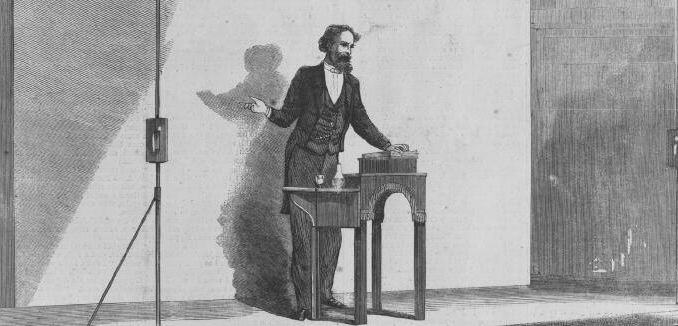
狄更斯在朗诵自己的作品
The Dickens bicentenary coincides with another leap in literary culture: the rise of electronic text. The debate about e-books still focuses on the merits of page vs. screen. But the far more profound effect will be in disrupting the numbers game of literature—the game that began with the Victorian fiction boom, which began with Dickens.
E-books are changing the idea of being in print. Publishing was designed as a Darwinian process in which authors compete to be printed and then thousands of books go the way of the
passenger pigeon
 . Digital flies, self-publishing and print-on-demand technologies raise the possibility that this natural selection will be
warped
. Digital flies, self-publishing and print-on-demand technologies raise the possibility that this natural selection will be
warped
 . The traditional definition of going out of print means that the content is no longer accessible. The digital version lives in
perpetuity
. The traditional definition of going out of print means that the content is no longer accessible. The digital version lives in
perpetuity
 . In some ways, that's a good thing but it exacerbates the problem of quantity.
. In some ways, that's a good thing but it exacerbates the problem of quantity.
The flood of books in the 19th century elicited two powerful institutional responses: the rise of prize culture and the rise of literature as a field of study. The message was that the masses needed help figuring out what to read, and the cultural elite was going to provide it. The Nobel Prize was first awarded in 1901, the Pulitzer in 1917. About the same time, the study of English literature became a mainstream field, and a
canon
 of approved literary texts began to take shape.
of approved literary texts began to take shape.
A century later, the curatorial influence of these institutions has been eroded by the same food that brought them into existence. The English canon, which came under pressure for being largely populated by dead white males, has been expanded and modernized. Prizes have
metastasized
 . As James English writes, the ratio of awards to new titles of fiction, poetry and drama has risen tenfold since the 1920s. At the same time, the culture of reviews and criticism has fragmented. Anyone with a smart phone can review a new novel, or an old one.
. As James English writes, the ratio of awards to new titles of fiction, poetry and drama has risen tenfold since the 1920s. At the same time, the culture of reviews and criticism has fragmented. Anyone with a smart phone can review a new novel, or an old one.
If Dickens had been around for the first Nobel, he wouldn't have won it. His style drew
scorn
 from critics for much of the early 20th century, when complicated, even
inhospitable
from critics for much of the early 20th century, when complicated, even
inhospitable
 writing came into fashion. (One of the tenets of modernism was that if it wasn't difficult, it wasn't art.) But regular people kept reading him. And around midcentury he was rescued by, among others,
George Orwell
writing came into fashion. (One of the tenets of modernism was that if it wasn't difficult, it wasn't art.) But regular people kept reading him. And around midcentury he was rescued by, among others,
George Orwell
 , who
latched onto
, who
latched onto
 him as a social critic. It was his dark, dreary novels that
did the trick
him as a social critic. It was his dark, dreary novels that
did the trick
 . They were presciently modern, it turned out. Dickens, so quintessentially of his time, was also ahead of it.
. They were presciently modern, it turned out. Dickens, so quintessentially of his time, was also ahead of it.
Once, an educated person could read pretty much everything important, because there weren't as many books and an educated person by definition possessed the money to buy books and the leisure to read them. The same publishing machine that helped spread literacy in the 19th century made it impossible for all the readers to read anywhere near all the books. Now the idea is laughable.
So the Dickens bicentenary is a celebration of his immortality, but it's also a celebration of consensus, a sigh of relief. The verdict on Dickens is sound. He's been questioned and cross-examined and voted in. The
exponential
 accumulation of fiction combined with the widening of its circle of stewards—prize givers and professors, yes, but also recommendation engines and top 10 lists—may make that kind of consensus difficult for future readers. They'11 have more writers to choose from, more tastemakers to choose them and infinite piles of books in the cloud. The advantage will go to those novelists who don't just reflect the culture but also transform it. Will the readers of the future find their 21st century Dickens on the Pulitzer roster or the best-seller list or FanFiction.net? This much is clear: on Feb. 7, 2112, they'11 be wishing the original Inimitable a very happy 300th birthday.
accumulation of fiction combined with the widening of its circle of stewards—prize givers and professors, yes, but also recommendation engines and top 10 lists—may make that kind of consensus difficult for future readers. They'11 have more writers to choose from, more tastemakers to choose them and infinite piles of books in the cloud. The advantage will go to those novelists who don't just reflect the culture but also transform it. Will the readers of the future find their 21st century Dickens on the Pulitzer roster or the best-seller list or FanFiction.net? This much is clear: on Feb. 7, 2112, they'11 be wishing the original Inimitable a very happy 300th birthday.
1812年,查尔斯·狄更斯诞生,那一年,英国有66部小说出版。其时人们写小说已有一百年的历史,但从没有人想到过把它当做一个职业。许多小说作品都没有署名,只是标明“一位女士著”等等。当时,以蒸汽为动力的印刷业尚处于“婴儿期”,而英国能读书、会写字的人还不到50%。大部分小说都被认为是愚蠢、伤风败俗、毒害民众或者干脆就是差劲的。
1870年,狄更斯去世,世人把他当做第一位文学名人来哀悼:一位职业作家和出版商,声名远播,受人爱戴。他使小说的出版数量和读者人数都有了爆炸式增长,他所创造的人物也被当做是道德的试金石。即使在今天,狄更斯的伟大地位依然无人能够挑战。如果英国文学的神圣殿堂里少了他,那就好比是卢浮宫卖掉了蒙娜·丽莎的画像一样。
狄更斯是如何达到如此登峰造极的地位的呢?不管读者对小说寄予多少情感,文学说到底就像数字游戏,又极难通过时间的考验。在维多利亚时代,从1837到1901年,大约有六万部小说得以出版;今天,一个普通读者大概只能说出其中的五六部。而狄更斯之所以能够经久不衰,部分原因在于他是位风格大师,其作品既有阳春白雪,也有下里巴人,能吸引各种品味的读者。还有一部分原因是他的职业生涯正赶上社会、政治和科学进步的浪潮。但除此以外,还有一个原因,那就是他改写了文学文化,并将自己置于文学文化的中心。谁都无法说清是什么样的才华、抱负、能量和运气使得狄更斯成为如此独树一帜的作家。但值其两百周年诞辰之际(编注:英文原文刊发于2012年1月),也许我们能弄清楚一件事:狄更斯本人是如何做到让自己经久不衰的。
狄更斯从事小说创作纯属偶然。年轻的时候,他渴望成为一位演员,而他所受的教育则要他成为一名记者。他时常也会随意写上几篇短篇小说。1836年,他接受一家杂志的委托,写一个喜剧短篇系列,每月14篇,与一套体育生活插图配套刊登。《匹克威克外传》就这样诞生了,引起了巨大的轰动。它确立了狄更斯举世无双的模仿大师的地位,不管是上流社会的头面人物,还是地位卑下的佣人,他都能惟妙惟肖地模仿其说话的语气。它同时也确立了狄更斯在系列作品方面天才作家的地位:那时书籍的价格昂贵,但价格低廉的期刊却很受欢迎,于是期刊连载便成了出版作品的标准做法。更为重要的是,《匹克威克外传》确立了他在经济上能够独立的艺术家地位,同时这部作品也在文学创作和商业盈利之间架起了一座桥梁。从创作《匹克威克外传》开始到离世之日,狄更斯一直都在为读者创作,同时也在为金钱创作——在他之前,这两者和艺术几乎没有任何关系。
狄更斯对读者的忠诚也使原本对立的双方之间产生了一种平衡:他在作品中创造出一种氛围,让读者觉得自己与他有着亲密的个人关系,借此他培养了一个庞大的读者群。读者们觉得他是在直接和他们对话,他也的确经常这样做。他将自己做一名演员的梦想转化为对作品充满激情的现场朗读。在读到《雾都孤儿》中南茜被残忍地杀害那一幕时,他那令人毛骨悚然的表演引起观众的阵阵晕厥。“是他发明了那种宣传形式,”哥伦比亚大学英语系主任、专门研究维多利亚时期英国文学的学者尼古拉斯·达姆斯指出,“他发明了营销策略。和出版文化能够扯上关系的所有那些东西基本上都是他首创的。”狄更斯本人也知道这一点。他称自己为“不可模仿者”,这个绰号后来一直保留了下来。
随着读者数量的增长,狄更斯特别注重保留自己的平民主义特色。在《大卫·科波菲尔》的创作和出版进行到一半的时候,他收到了一位熟人的来信,信中对小说里一个次要人物——莫切尔小姐——表达了反对意见。在小说中,莫切尔小姐设下圈套,涉嫌参与了引诱大卫的儿时玩伴小艾米莉的阴谋。巧合的是,和这位写信者一样,莫切尔小姐也是个侏儒。狄更斯解释说他笔下的所有人物都是各种性格的复合体,他本人并无意暗示身体上的缺陷就代表着灵魂的缺陷。但是,当莫切尔小姐再次在小说中露面时,狄更斯就改主意了,抹去了她做的所有坏事。这一变化有点别扭和不合常理,但狄更斯更看重抚慰读者受伤的心灵。他觉得自己要对她负责,对所有读者负责,而读者给他的回报则是对他的崇拜。
狄更斯对其作品的反应是迅速的,他知道,只有他保持对作品的控制能力,他的作品才会有生命力。在他创作生涯刚刚开始时,作者在英国国内只拥有有限的版权保护,而在海外则几乎没有任何保护。美国杂志就公然盗版他的作品。狄更斯成功地在英国国内争取到了更为强势的版权条款,在国际上也签定了相关协定,以阻止未经授权的翻译和剽窃。他甚至呼吁成立一个作家联盟。作为两个周刊的总编,他一直在扶植新的人才,致力于让作者从自己的作品中获利,不管是生前还是身后。
在小说中,狄更斯也开始思考身后事了。他早期的小说都植根于他所在那个时代所特有的问题,比如1834年颁布的《济贫法》(《雾都孤儿》)、约克郡虐待儿童的学校(《少爷返乡》)等。随着他日渐成熟,他的批判也变得愈加隐晦。他开创了用讽喻的手法描写巨大社会弊端的先河,比如《小杜丽》中的“兜圈子办公室”,还有《荒凉山庄》中在英国法庭上演的寄生虫式的“詹狄士状告詹狄士”诉讼案——这些庞大的由腐败和低效构成的“粉碎机”足以令每一个闯入者粉身碎骨。人们在阅读《雾都孤儿》时,能够知道责任在谁,问题在哪儿。但在读狄更斯后期的小说时,就像达姆斯说的那样,“你再也无法看出谁是坏蛋了。一切都似乎自成体系。”
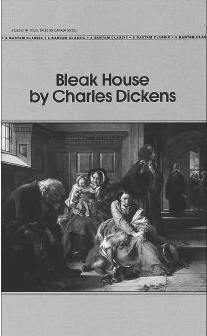
《荒凉世界》英文版封面
批评家觉得这些小说沉闷枯燥、冗长散漫。亨利·詹姆斯在1865年为《国家》杂志撰写《我们共同的朋友》的书评时指出,“在我们看来,过去的十年时间里,狄更斯先生一直在强迫自己写作,这一点是显而易见的。《荒凉山庄》是硬逼出来的;《小杜丽》写得非常吃力;而《我们共同的朋友》简直是用铁锹和镐硬挖出来的。”但狄更斯并不为批评家而创作。他对喜剧和感伤作品驾轻就熟,深得忠实读者的欢心。而且,他开始考虑一个新的读者群:子孙后代。

《雾都孤儿》英文版封面
狄更斯为自己身后留名做的最后一件事是委任他的密友约翰·福斯特作为自己的传记作家。在这位伟大的作家去世两年之后,福斯特撰写的《查尔斯·狄更斯的一生》面世了。书中讲述了一件事,这件事狄更斯一直羞于示人,仅仅告诉了身边少数人:小时候,父亲因欠债入狱的那段时间里,他曾一度被送到鞋油厂打工。这件事让读者们深感震惊。他们早就知道童年打工的细节,但那是少年大卫·科波菲尔的情况——大卫曾说过自己在十岁时被冷酷无情的继父“扔”在一家货栈打工。他们也知道艾米·杜丽出生在关押欠债者的牢房里,那是她父亲被关押的地方。他们还知道《远大前程》中的主人公皮普为自己出身低贱而感到羞辱,终生背负着这个沉重的负担。但直到福斯特的传记出版,他们才知道这些耻辱的根源。这是狄更斯安排的最后的情节转折,现在终于真相大白:在那些书中人物内心最为脆弱的时刻,原来是他们的创造者在讲述自己的亲身经历。这让他的读者感到意外,却也使他永远活在他们心中。
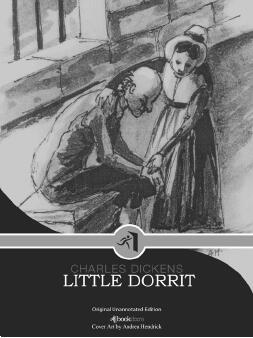
《小杜丽》英文版封面
狄更斯诞辰两百周年恰逢文学界的又一飞跃:电子文本的兴起。人们关于电子书的争论依然围绕着纸质书与电子屏幕的孰优孰劣。但电子书更为深刻的影响是它会干扰文学领域的“数字”游戏。这种游戏始于维多利亚时代小说的兴盛时期,以狄更斯为先导。
电子书改变了人们关于出版的概念。出版是一个优胜劣汰的过程,作者们相互竞争,抢夺出版机会,然后成千上万的书像已经灭绝的旅鸽一样消失不再了。数字文档、自我出版以及按需印刷等技术极有可能使这种自然淘汰过程发生改变。传统的绝版概念意味着书的内容已不可获得。而数字版本的图书则会永远存在。从某种意义上说,这是好事,但它却使量的统计更加困难。
19世纪海量书籍的出版催生了两种影响力深远的新生事物:一是奖励文化的兴起,二是文学作为一种研究领域的兴起。它们传达给我们的是以下信息:民众需要帮助以确定阅读什么,而文化精英可以提供这种帮助。于是,诺贝尔奖于1901年首次颁发,普利策奖于1917年首次颁发。几乎与此同时,英国文学研究成为主流研究领域,而公认的经典文学作品的名单也开始形成。
一个世纪以后,这些新生事物作为评议者的影响力已经受到侵蚀,而侵蚀它们的正是过去催生它们的海量书籍。由于主要被逝世的白人男作家所占据,英国经典文学的名单从一诞生就伴随着压力,如今这一名单的范围已经扩大并且已被现代化。而各种奖励已经像癌细胞一样扩散。正如詹姆斯·英格利士所指出的那样,自20世纪20年代以来,颁发给小说、诗歌和戏剧新作的奖励比例上升了十倍。与此同时,评论与批评文化已变得支离破碎。任何一个拿着智能手机的人都能够对新篇旧作发表评论。
在首届诺贝尔奖颁奖时,即使狄更斯还活着,他也无缘获得。在20世纪初期的大部分时间里,评论者对狄更斯的写作风格都嗤之以鼻,当时流行的是那种错综复杂甚至不近人情的作品。(现代主义的原则之一:不晦涩就不是艺术。)但还是有一些忠实读者一直在阅读他的作品。直到20世纪中叶,狄更斯才被一些人从“冷宫”中拯救出来,其中一个拯救者就是乔治·奥威尔,他十分欣赏狄更斯作为社会批评家的成就。这其中发挥奇效的正是狄更斯那些隐晦、沉闷的小说。人们发现,这些作品竟然如此超前地具有现代主义风格。狄更斯是他所在时代的典型代表,但同时也超越了那个时代。
曾经,一个受过教育的人差不多可以读到所有重要的书籍,一是因为当时书籍不多,再者是因为受过教育的人当然有钱去买书,也有闲暇去读书。然而,19世纪时曾大力普及文化知识的同一台出版机器,现在却不可能让任何读者哪怕是接近读完所有的书籍。读遍天下书的想法如今只能沦为笑柄。
因此,狄更斯诞辰两百周年纪念既是庆祝他的不朽地位,也是庆祝人们终于达成一致意见,可以松口气了。人们对狄更斯的看法,经历了质疑、反复盘问乃至最后投票表决,最终得出了合情合理的裁定。在将来,要为读者作出一个类似的裁定将变得更加困难,因为小说数量在呈指数级增长,而且评判者的圈子也变得越来越大——有颁奖机构和大学教授,还有网站的推荐引擎和十大优秀图书排行榜等等。他们需要从更多的作家中进行筛选,需要有更多的仲裁者来进行仲裁,还有一堆堆高耸入云的图书需要评判。那些不仅反映文化而且改变文化的作家无疑将占据优势。那么,在普利策获奖者名单上,在畅销书排行榜上,或者在同人小说网站上,未来的读者能否找到他们21世纪的狄更斯呢?有一点是显而易见的:2112年2月7日,他们将会向这位富有创意的“不可模仿者”道一声:“三百岁生日快乐!”